Food grade lubricants – are they environmentally friendly and biodegradable?
- Like
- Digg
- Del
- Tumblr
- VKontakte
- Buffer
- Love This
- Odnoklassniki
- Meneame
- Blogger
- Amazon
- Yahoo Mail
- Gmail
- AOL
- Newsvine
- HackerNews
- Evernote
- MySpace
- Mail.ru
- Viadeo
- Line
- Comments
- Yummly
- SMS
- Viber
- Telegram
- Subscribe
- Skype
- Facebook Messenger
- Kakao
- LiveJournal
- Yammer
- Edgar
- Fintel
- Mix
- Instapaper
- Copy Link
Posted: 23 May 2007 | Dr Mary Moon, Bel-Ray Company, Inc | No comments yet
Needs unique to the food processing industry have motivated the development of food grade lubricants.1-4 These lubricants are formulated to minimise risks associated with unavoidable occasional trace contamination in food and beverages. Well-defined regulations specify standards for food grade lubricants in certain nations.1,5 A new international standard for food processing hygiene will stimulate more widespread regulation and use of these products throughout the world.6
Needs unique to the food processing industry have motivated the development of food grade lubricants.1-4 These lubricants are formulated to minimise risks associated with unavoidable occasional trace contamination in food and beverages. Well-defined regulations specify standards for food grade lubricants in certain nations.1,5 A new international standard for food processing hygiene will stimulate more widespread regulation and use of these products throughout the world.6
Needs unique to the food processing industry have motivated the development of food grade lubricants.1-4 These lubricants are formulated to minimise risks associated with unavoidable occasional trace contamination in food and beverages. Well-defined regulations specify standards for food grade lubricants in certain nations.1,5 A new international standard for food processing hygiene will stimulate more widespread regulation and use of these products throughout the world.6
Food processors can be confident that unintentional trace contamination of their products by microscopic levels of food grade lubricants is very low risk. Because these lubricants have an excellent reputation for safety, many processors inquire:
- Are food grade lubricants environmentally friendly?
- Do they reduce risks of pollution and environmental contamination?
- Is spilled lubricant biodegradable?
The purpose of this article is to address these questions and contribute to the understanding of lubricants in the food processing industry. Food grade, environmentally friendly, and biodegradable lubricants are defined and compared. Their formulations and applications are also described.
Food Grade Lubricants1-15
In the food processing industry as in many other industries, lubricants serve many purposes:
- Prevent contact between moving metal components in machinery
- Release agents on gaskets, seals of tank closures, grills, moulds, etc.
- Protective anti-rust films
Lubricants are critical to manufacturing operations. They minimise damage due to friction, wear, and overheating in machine parts (gears, chains, bearings). Figure 1 shows that these moving parts are essential to grinders, mixers, pumps, ovens, motors, pneumatic tools, compressors, conveyor belts, and hydraulic systems that are in constant use at bakeries, facilities for canning, bottling, and packaging, as well as meat, poultry, and other food processing plants.
Selection of appropriate lubricants is essential for efficient and reliable processing operations. Machinery (and lubricant) lifetimes depend upon having “the right lubricant in the right place at the right time”. The food processing industry offers some unique challenges for lubricants. Their requirements often include continuous operations, temperatures characteristic of freezing, baking and grilling, resistance to water, steam, chemicals, food, and compatibility with synthetic materials used for tubing, seals, belts, etc.13 Furthermore, food processing involves the potential for incidental contact of food and beverages with lubricants. In the food processing and lubrication industries, incidental contact is generally accepted to refer to contact that is not intended but which can occasionally occur.1-13
It is nearly impossible to completely protect food and beverages from incidental contact with lubricants. Splashes, leaks, drips, sprays, etc. can discharge lubricant from equipment. Contamination by many ordinary lubricants can affect the aroma, flavour, and appearance of food and beverages, and irritate the skin, eyes, and gastrointestinal tract of consumers.7 Recalls are costly not only in terms of lost revenue, but also due to unfavorable publicity, loss of brand equity, and legal liability.7
Each country has the authority to set national requirements for food processing hygiene. The USFDA (United States Food and Drug Administration) has documented the following requirements in the U.S. Code of Federal Regulations Title 21 Food and Drugs (CFR 21), Section 178.3570, Lubricants with incidental food contact:5
Lubricants with incidental food contact may be safely used on machinery used for producing, manufacturing, packing, processing, preparing, treating, packaging, transporting, or holding food, subject to the provisions of this section:
(a) Lubricants are prepared from one or more of the following substances:
(1) Substances generally recognized as safe for use in food
(2) Substances used in accordance with the provisions of a prior sanction or approval
(3) Substances listed in Section 178.3570
(b) The lubricants are used on food-processing equipment as a protective anti-rust film, as a release agent on gaskets or seals of tank closure, and as a lubricant for machine parts and equipment in locations in which there is exposure of the lubricated part to food. The amount used is the minimum required to accomplish the desired technical effect on the equipment, and the addition to food of any constituent identified in this section does not exceed the limitations prescribed.
(c) Any substance employed in the production of the lubricants described in this section that is the subject of a regulation in parts 174, 175, 176, and 179.45 of this chapter conforms with any specification in such regulation.
CFR 21, Section 178.3570 specifies limitations on the levels of the listed substances. Mineral base oil and certain synthetic base oils are not to exceed 10 ppm (parts per million) in food, i.e. 1 milligram per kilogram of food. Other chemical substances used to modify the base oil (see below) are limited by weight in the finished lubricant. These limitations implicitly define incidental contact between lubricants and food. In other words, incidental contact can be understood to mean contact that results in 10 ppm or less of base oil in food.
The USDA (United States Department of Agriculture) developed the H1 category for lubricants that comply with CFR 21, Section 178.3570. The USDA registered and listed H1 lubricants through 1998.1-4 Management of H1 registered lubricants was continued by NSF International (Ann Arbor, MI, USA) in 1998.1 NSF International is a not-for-profit organisation that specializes in standards development, product certification, education, and risk-management for public health and safety.1 NSF’s voluntary Nonfood Compounds Registration Program authorises and lists over 8700 lubricants, disinfectants, washing agents, and other nonfood compounds used in and around food processing establishments.14
NSF International registers and classifies the formulations of lubricants for use in the food processing industry, Table 1.1-4,12 Lubricants are listed as nonfood compounds on the web site www.nsfwhitebook.org. The NSF Registration Number, Category Code, and Registration Mark appear on the NSF approved product labels of registered lubricants.1
NSF H1 registered lubricants are acceptable as lubricants with incidental contact for use in and around food processing areas according to the USFDA. They are formulated with chemical substances from CFR 21, Section 178.3570. NSF International also registers and lists HX-1 chemical products which comply with CFR 21, Section 178.3570. The HX-1 chemicals can be used as ingredients in H1 lubricants.
In addition, NSF International registers H2 lubricants for use on equipment in food processing facilities where there is no possible contact with food or beverages. The restrictions on H2 formulations are less stringent than for H1 lubricants. H3 products are water-soluble oils; they are acceptable for incidental contact in certain applications, Table 1. (Note: NSF International also registers 3H Release Agents, which are Proprietary Substances rather than Nonfood Compounds. They are used to coat the surfaces on grills, ovens, loaf pans, boning benches, chopping boards, or other hard surfaces in contact with meat and poultry food products to prevent food from adhering during processing. The USFDA regulates these substances as food additives.15)
In the food processing and lubrications industries, “food grade lubricant” is understood to mean NSF H1 (and, less commonly, H3)12 lubricants registered for incidental food contact.2-4,13 They are specially formulated to be generally low-hazard, odorless, and tasteless. They minimise risks associated with incidental contact of lubricants with food and beverages during processing operations.
Food grade (H1) lubricants are used around the world. Kroll (NSF International) reported that the NSF Website lists 4566 registered H1 lubricants marketed by 450 companies from 31 countries (February 6, 2007).14 For example the Australian Quarantine Inspection Agency (AQIS) approved about 100 products on the basis of NSF H1/H2 registration.2
Interest in food hygiene continues to spread globally. ISO (International Organisation for Standardisation) recognises the significance of good hygiene in food processing. ISO recently approved and accepted the final draft of a new international standard to serve as the cornerstone for the development of new national standards. ISO/FDIS 21469 Safety of Machinery – Lubricants with incidental product contact – Hygiene requirements states:6
This International Standard specifies hygiene requirements for the formulation, manufacture, use and handling of lubricants which, during manufacturing and processing, can come into incidental contact with products and packaging used in the food-processing, cosmetics, pharmaceutical, tobacco or animal-feeding-stuffs industries.
According to Section 5.3, lubricants for incidental contact with food and beverages are to contain only substances listed or authorized by suitable national/international sources specifying acceptable substances, e.g., CFR 21, Section 178.3570, Joint FAO/WHO Expert Committee on Food Additives, and Council Directive 95/2/EC.6
Food grade lubricants (NSF H1 registered for incidental contact with food and beverages) contain only substances specified by CFR 21, Section 178.3570. They are consistent with the compositional requirements outlined in ISO 21469. NSF International is currently developing an ISO 21469 product certification program. This certification program will not replace the existing H1 category.14
Formulation of food grade lubricants
Composition of food grade (H1, H3) lubricants is defined by CFR 21, Section 178.3570.5 Formulations are developed to meet technical requirements including OEM specifications for machinery. Open, closed, and worm gear oils, hydraulic fluids, chain lubricants, cylinder oils, and can seamer oils are examples of specialised products. Lubricant formulations may also be required to meet applicable laws and regulations pertaining to occupational, health, safety, and environmental considerations.
In non-technical terms, lubricants are mixtures of oil and low levels of additives which enhance performance. Lubricants consist primarily of base oils. Three types of base oils are used to formulate food grade lubricants:
- Very pure grades of “white” mineral oils are highly refined from naturally-occurring deposits of petroleum.
- Synthetic base oils such as PAOs (polyalphaolephins), PAGs (polyalkalene glycols), and silicones are manufactured.
- Vegetable oils including castor, palm, soybean, canola (rapeseed) and sunflower oils are harvested from crops.
Base oils have limited capabilities as lubricants. It is necessary to modify them with chemical additives in order to improve their performance. Additives comprise a small percentage of most formulations but make critical contributions. They are chosen on the basis of performance requirements, solubility in the specific base oil, and possible interactions between additives.
The main types of additives used in food grade lubricants are:
- Friction modifiers, anti-wear additives, extreme pressure additives
- Antioxidants
- Corrosion and rust inhibitors
- Viscosity modifiers and pour point depressants
- Surfactant detergents, dispersants, and emulsifiers
- Antifoam agents and defoamers
Material Safety Data Sheets (US, Canada, Latin America) and Safety Data Sheets (Europe, Australia) contain information about hazards associated with bulk lubricants, including potentially harmful health and environmental effects. Applicable laws and regulations govern the disposal of bulk lubricants “as supplied” and after use, and the remediation of unintended release (spills).
Environmentally friendly lubricants (Biolubricants)16-21
Food grade lubricants are understood to mean H1 (and H3) products whose formulations are formally registered and meet well-defined criteria (CFR 21, Section 178.3570). Many technical properties (viscosity, flash point, anti-wear, anti-rust) are measured with well-established standard test methods. For environmental considerations, a consensus is evolving on terminology, tests methods, and regulations. Environmental considerations include raw material selection, release during use, unintentional release, and disposal.
“Environmentally friendly”, “environmentally advantaged”, and “environmentally acceptable” lubricant (or “biolubricant”) have not been defined universally.16-20 These terms can refer to a lubricant (or ingredient) which satisfies a specific environmental regulation (below) or simply has a potential advantage over alternatives vis-à-vis environmental considerations such as:
- Base oil other than mineral oil
- Base oil derived from “renewable” sources, i.e., vegetable oils
- Lower level or absence of one or more additives believed or known to have deleterious effects on humans, animals, or plants
- Lower level or absence of VOCs (volatile organic compounds)
- Believed or known to be decomposed faster than conventional products by naturally-occurring bacteria present in soil or water (biodegradable)
- Contain inert ingredients that are not decomposed by naturally-occurring bacteria present in soil or water
- Longer service lifetime / less frequent disposal and replacement
Beitelman suggested that environmentally friendly lubricants (EFLs) were first required in 1985 for power chain saws in the Black Forest in Europe.16 Chain saw lubricants are “total loss lubricants” as shown in Figure 2. That is, the lubricant is released into the environment during / immediately after use. Total loss lubricants present a particular risk for contamination of soil and water for this reason. Certain other lubricants are less likely to come into contact with the soil and water, unless there is an unintentional release or improper disposal.
Some nations have specific requirements for lubricant use on inland and coastal waterways and other sites where there is significant risk of environmental damage due to lubricant release.16,18 For example, Sweden, Holland, Germany, Japan and the United States have their own specifications for environmentally friendly hydraulic fluids for mobile equipment to limit environmental damage in the event of a spill or leak.18 In 2003, a comprehensive European project (LLINCWA) reported that biolubricants performed as well or better than conventional lubricants in over 40 field trials in water pumping stations, barges, bridges, water treatment plants, etc.19 LLINCWA concluded that higher purchase price and the need for widely-accepted definitions and international standards were the major barriers to biolubricants.19
In 2005, The Commission of the European Communities adopted criteria for awarding the European Community Eco-Label to hydraulic oils, greases, chainsaw oils, two-stroke engine oils, concrete release agents, and other total loss lubricants for use by consumers and professional users.20 The criteria are:20
- No relevant R-phrases for composition indicating environmental and human health hazards
- Additional aquatic toxicity requirements
- Biodegradability and bioaccumulative potential
- Exclusion of specific substances (organic halogen compounds, etc.)
- Renewable raw materials (minimum percent carbon content from vegetable oils or animal fats)
These criteria were selected in order to promote lubricants that reduce harm to the water and soil during use, and lead to lower CO2 emissions. The EC Eco-Label is awarded to products and services with reduced environmental impact. The Eco-Label program is part of the European Community’s policy on the environment and sustainable economic development. This program is intended to encourage businesses to market environmentally friendly products.21
As of this writing, there has not been a strong specific focus on the development and use of environmentally friendly lubricants for the food processing industry. Nontoxic U.S.P. White Mineral Oil used in many food grade lubricants does not meet typical biodegradability criteria (below); some synthetic base oils may do so.17 Food grade lubricants per se present less risk for contact with the environment than total loss lubricants. Applicable laws and regulations govern the disposal of food grade lubricants and the remediation of spills, and generally are no different than for most other lubricants.
Biodegradable Lubricants16-34
Biodegradability is one of the properties of environmentally friendly lubricants discussed above. Interest in biodegradable lubricants continues to gain momentum for reasons discussed below.22
Biodegradability refers to the tendency for a lubricant to be chemically decomposed by naturally-occurring bacteria in soil and water. That is, bacteria consume hydrocarbons present in base oils (and some additives). A series of chemical reactions is required to completely transform the hydrocarbons into CO2, water, and trace minerals.18,26 Biodegradation causes lubricant to dissipate after release into the environment.18,23,24,26 Biodegradability can be measured in field tests. The level of contamination in soil is monitored after a controlled release of lubricant.23
In practice, standard laboratory tests are more often used to evaluate biodegradability.18-20,23 These tests measure rates of chemical conversion of lubricants by bacteria. They are frequently carried out in the presence of air (“aerobic”) and water (“aqueous”), under well-controlled conditions:
- Primary biodegradability refers to the first step in the biodegradation process. It is measured according to CEC L-33-A-94.25 Lubricant and bacteria are mixed in an aqueous solution. The disappearance of hydrocarbons is monitored for 21 days using infrared spectroscopy.
- Ultimate biodegradability refers to the final step of biodegradation, which is the production of CO2. ASTM D-586426 and OECD 301 B27 are used to measure CO2 production for 28 days. An aqueous solution of bacteria and lubricant is sealed in a flask. Air flow to the flask is controlled. Air without CO2 enters the flask, mixes with CO2 produced by biodegradation, leaves the flask, and is analysed. The final result is the total percentage of carbon converted into CO2 by bacteria, which indicates ease of biodegradation in the environment.26
It is generally understood that 60 per cent or more ultimate biodegradation after 28 days of testing according to ASTM D-5864 or OECD 301 B can serve as a benchmark for biodegradable lubricants. A lubricant is considered to be readily biodegradable when there is 60 per cent or more ultimate biodegradation.17,19,22 National specifications for environmentally friendly hydraulic fluids for mobile equipment typically require ultimate biodegradability which is 60 per cent or more, (or 70 per cent or more) after 28 days.18 Criteria for the EU Eco-Label require that each ingredient in a lubricant have ultimate biodegradability of 60 per cent or more after 28 days and pass other biodegradability tests as well.20
Biodegradability, or lack thereof, is a major determinant of the environmental hazard presented by release of a lubricant.17,19,20,23,24 According to the National Research Council, the release of petroleum (and lubricants based on mineral oils) can be hazardous to the environment for several reasons. Their effects on fish, birds, and other wildlife are well-known as shown in figure 3. Petroleum contains known carcinogens such as polycyclic aromatic compounds. Petroleum and mineral oils form viscous, “sticky” coatings and deposits in soil, sediments, shorelines, and even deep or undisturbed water. These materials are persistent. They do not rapidly dissipate. Moreover, they tend to accumulate over the long term in soil and water. Even petroleum residues on roads and in soil contaminate water “runoff” and have a significant effect on waterways.24
Biodegradable lubricants contain vegetable oils and certain synthetic base oils, which can biodegrade and dissipate much more rapidly than mineral base oils. Biodegradable hydraulic fluids18 and other total loss lubricants20 were first devised in response to specific mandates for their use. Even more recently, biodegradable multipurpose grease23, rail curve grease,28 wheel flange lubricant,29 and open gear lubricant30 have been developed. Figure 4 shows raw soy beans which provide soy bean base oil for many biodegradable lubricants.
Profound factors (which can be regarded as part of the Sustainability Revolution31) are creating opportunities for the development and application of biodegradable lubricants:
- Agricultural organisations are supporting research to develop new nonfood uses for crops (vegetable oils). For example the United Soybean Board partnered with manufacturers to develop 22 new soy-based nonfood products in 2006.32
- Government programs are encouraging the use of renewable resources. The 2002 US Farm Security and Rural Investment Act requires federal agencies to purchase biobased over petroleum-based products, given reasonable availability, price, and performance. Biobased products are nonfood goods that contain significant levels of agricultural, forestry, or other renewable materials.33
- Research and development is creating plant-based (carbohydrate) alternatives to petroleum-based (hydrocarbon) chemical feed stocks and energy supplies.34
The development of plant-base oils is enabling advances in biodegradable lubricants. While biodegradable lubricants are not widely used in the food processing industry at this time, it is likely that they will be in the future.
Conclusions
Food grade lubricants are well defined and that definition does not include environmentally friendly or biodegradability requirements. A food grade lubricant may or may not have environmentally friendly or biodegradable characteristics without violating regulatory requirements. Because food grade lubricants are not usually released into the environment during or after use, the risk of pollution is relatively low. While most current food grade lubricants are not biodegradable, new regulations, technological improvements such as better base oils, and the shift toward renewable materials will drive future developments to include environmentally friendly and biodegradable food grade lubricants.
In conclusion, most current food grade, environmentally friendly, and biodegradable lubricants have significantly different properties, Table 2. These types of products are not generally interchangeable.


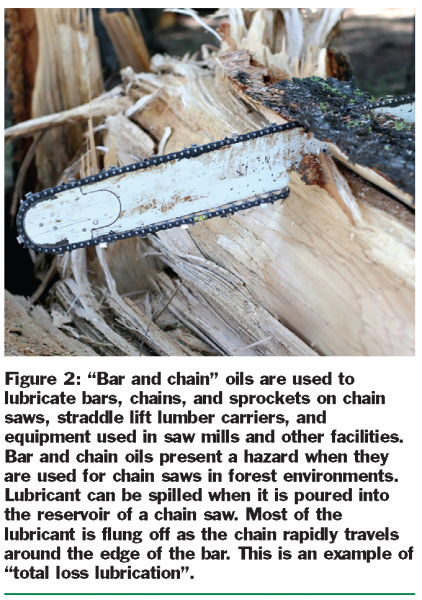

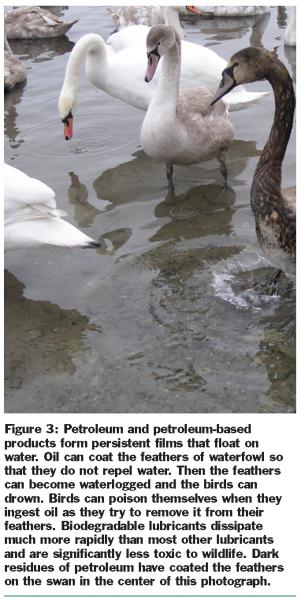

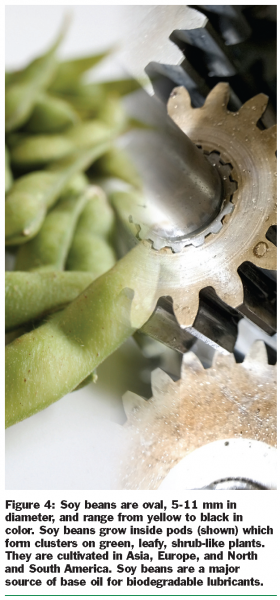

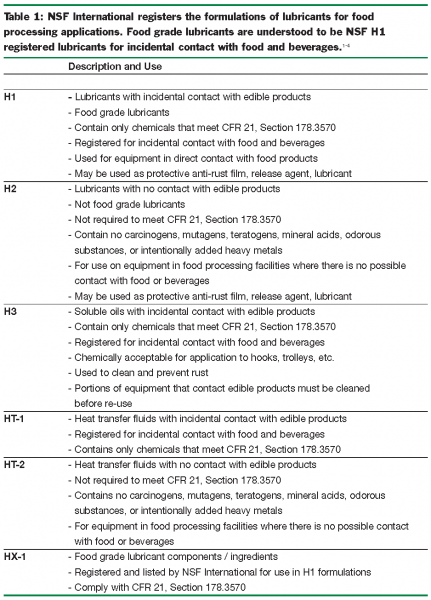

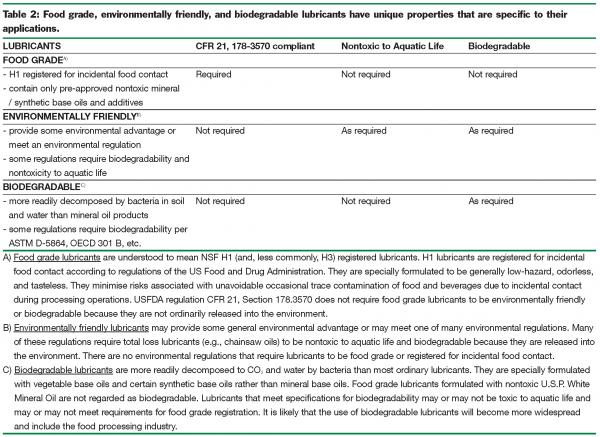

References
- http://www.nsf.org/business/nonfood_ compounds/
- Yano, K., “Globalization of Food-grade Lubricant Market and International Standard”, Paper #0513, Presented at the NLGI 72nd Annual Meeting, San Antonio, Texas, USA, October 30 – November 1, 2005.
- Yano, K., New Food, 7(3), 2004, 44-47.
- Yano, K., Food Safety Magazine, April, 2004.
- Code of Federal Regulations, Title 21, Volume 3, section 178.3570, Lubricants with incidental food contact, [21CFR178.3570], http://ecfr.gpoaccess.gov/cgi/t/text/text-idx?c=ecfr&sid=d72ca4c7aa7d5c7527ce9500b84c5…
- Final Draft International Standard ISO/FDIS 21469 Safety of Machinery – Lubricants with incidental product contact – Hygiene requirements, Reference number ISO/FDIS 21469:2005(E).
- Judge, D., New Food, 7(1), 2004, 67-71.
- Girard, J., Machinery Lubrication, July, 2002.
- Judge, J., Machinery Lubrication, July, 2005.
- Hodson, D., Machinery Lubrication, Jan., 2004.
- Raab, M.J. and Lesinski, D.J., Machinery Lubrication, May, 2005.
- Williamson, M., Machinery Lubrication, January, 2003.
- Hunt, J., South African Food and Beverage Manufacturing Review, May, 2001.
- Krol, Sarah, NSF International, Personal communication, February 6, 2007.
- Code of Federal Regulations, Title 21, Volume 3, Part 170 Food Additives, Section 170.3 Definitions, http://www.cfsan.fda.gov/~lrd/FCF170.html
- Beitelman, A.D., “Environmentally Friendly Lubricants”, U.S. Army Construction Engineering Research Laboratories, The REMR Bulletin, 13(2), May, 1996, http://www.wes.army.mil/REMR/bulls/vol13/no2/text/lubs.html
- Department of the Army, U.S. Army Corps of Engineers, Manual No. 1110-2-1424, Engineering and Design – Lubricants and Hydraulic Fluids, EM 1110-2-1424, 1999.
- Battersby, N., Proceedings 15th International Colloquium Tribology Automotive and Industrial Lubrication (2004), Technische Akademie Esslingen, Stuttgart, Germany, 735-742
- Van Broekhuizen, P., Theodori, D., Le Blansch, K., and Ullmer, S., Eds., Lubrication in Inland and Coastal Waterways (LLINCWA), A.A. Balkema Publishers / Taylor and Francis Group, London (2003)
- Commission Decision of 26 April 2005 establishing ecological criteria and the related assessment and verification requirements, for the award of the Community eco-label to lubricants (notified under document C(2005) 1372), (Text with EA relevance), (2005/361/EC), Official Journal of the European Union, L 118/26, May 5, 2005.
- http://ec.europa.eu/environment/ecolabel
- Honary, L. A., Machinery Lubrication, Sept., 2001.
- Rhee, I.S., NLGI Spokesman, 64(1), April, 2000, 8-17.
- Rablais, N., Oil in the Sea III: Inputs, Fates, and Effects, National Research Council of the National Academies, Public Briefing, May 23, 2002, Opening Statement.
- CEC-L-33-A-93, “Biodegradability of Two Stroke Outboard Engine oil in Water”, Coordinating European Council, 1994.
- ASTM D-5864, “Standard Test Method for Determining Aerobic Aquatic Biodegradation of Lubricants or Their Components”, ASTM International, West Conshohocken, PA, USA, 2000.
- OECD 301 B, “Guidelines for Testing of Chemicals, Ready Biodegradability: Modified Sturm Test”, Organization for Economic Cooperation and Development, 1993.
- Honary, L.A.T., NLGI Spokesman, 68(7), Oct. 2004, 24-33.
- Stempfel, E.M., and Baumann, M., NLGI Spokesman, 68(2), May, 2004, 8-23.
- Faci, H., Medrano, A., and Cisler, B., NLGI Spokesman, 67(12), March, 2004, 10-17.
- Edwards, A.R., The Sustainability Revolution – Portrait of a Paradigm Shift, New Society Publishers, 2006.
- http://www.unitedsoybean.org
- http://www.biobased.oce.usda.gov /fb4p/aboutus.aspx
- Morris, D., http://www.prospect.org/web/page.ww?section=root&name=ViewPrint&articleId=11313
- http://www.foodtimeline.org/foodfaq1.html
- http://en.wikipedia.org/wiki/Doughnut
- http://www1.salvationarmy.org.uk
- http://itold.com/articles/314/the-story-of-doughnuts/



